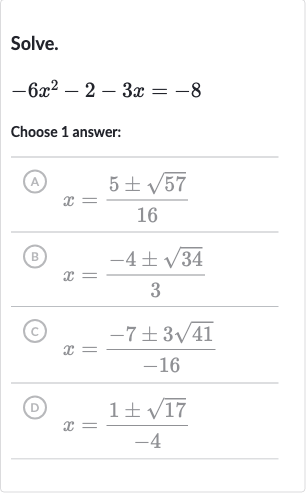AI tutor
Full solution
Q. Solve.Choose answer:(A) (B) (C) (D)
- Bring to Standard Form: First, we need to bring the equation to standard quadratic form by moving all terms to one side.Now, add to both sides to get all terms on one side.
- Simplify Equation: Simplify the equation by combining like terms. Now we have a quadratic equation in standard form.
- Calculate Discriminant: To solve the quadratic equation, we can use the quadratic formula , where , , and . First, calculate the discriminant (). Discriminant = Discriminant = Discriminant = Discriminant =
- Apply Quadratic Formula: Now, plug the values of , , and the discriminant into the quadratic formula.
- Simplify Square Root: Simplify the square root of the discriminant if possible. Since is not a perfect square, we leave it as . Now we have two possible solutions for : or
- Factor Out : We can simplify the solutions further by factoring out a in the numerator. or or
- Check Options: Now, we compare our solutions with the given options. None of the options match our solutions exactly, but we can check if the discriminant we found can be simplified to match any of the options. can be simplified to , which is .
- Replace Square Root: Replace with in our solutions. or or
- Match Solutions: Now, our solutions match option (D). or
More problems from Solve a quadratic equation using the quadratic formula
QuestionGet tutor help
QuestionGet tutor help
QuestionGet tutor help
QuestionGet tutor help
QuestionGet tutor help
QuestionGet tutor help
QuestionGet tutor help
QuestionGet tutor help

